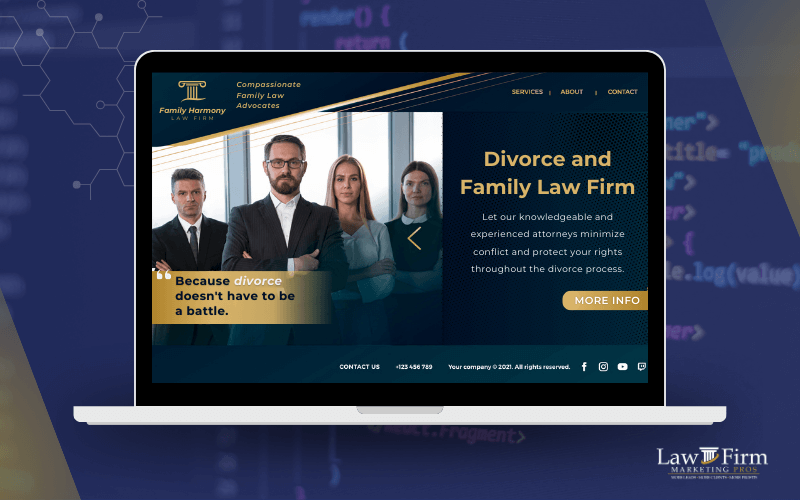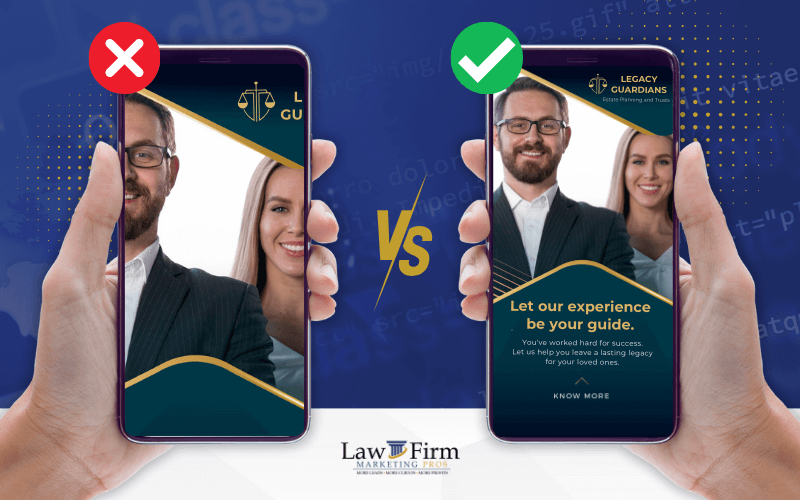Your law firm website is not just a tool; it’s a foundational marketing asset that can make or break your professional branding. Crafting a website that effectively communicates your law firm’s brand and value proposition and attracts quality leads is a critical element for law firm SEO, turning potential clients into retained clients, and increasing your bottom line. Creating a high-impact, lead-generating law firm website may seem overwhelming, but with these three key building blocks, you’ll be well on your way:
- The support of the law firm leadership
- A skilled team
- A strategic website design process that prioritizes user experience and content strategy
While the first two are within your control, the crucial third element—the law firm web development process—brings it all together and propels your project forward. Embarking on a web redesign project can be challenging, but with the right process, you can navigate the complexities and pitfalls that often derail the goal of creating a well-designed website that converts. At Law Firm Marketing Pros, we have over a decade of experience developing law firm websites, refining our proven process that delivers the optimized website of your dreams, without headaches. Are you ready to unleash the full potential of your law firm website redesign? This blog shares valuable insights and lessons learned from our research, analytics, and over a decade of experience creating the best law firm websites. Continue reading to discover more, then contact us to schedule a free 15-minute discovery call at (561) 948-5001.
Who Should Read This Blog About Law Firm Websites?
This blog is a must-read for professionals involved in the creation or management of attorney websites—specifically, marketers and stakeholders responsible for overseeing the project. We’ll demystify the process of creating lawyer websites to enable you to:
- Learn from the best law firm websites
- Promote your legal services and your law firm’s mission to the right audience
- Turn prospective clients into happy clients

The Purpose of Law Firm Websites: Build Credibility, Establish Trust & Convert Qualified Leads Into Clients
In the realm of attorney web design, we have worked with various practice areas, each with its unique configurations and purposes.
Regardless of the practice area, law firm websites must convey credibility because prospective clients seek services from professionals they can trust. Even solid referrals are not always enough to secure a client. Our research has shown that potential clients will visit your law firm website to validate a referral, and may dismiss a referral based on the information they find, or don’t find. These prospects understand that they are purchasing complex services that typically involve a significant financial investment and a high level of risk. Such transactions are far from the impulsive purchases that characterize the B2C (and sometimes B2B) space.
Regarding websites for professional legal services, establishing trustworthiness and credibility to attract and retain clients is critical. Particularly in a practice area like family law, the lengthy sales process can take months or even years. During this time, potential new clients come across your firm long before they are ready to make a decision. That’s why your website must engage with prospects at every step of the buying journey—from initial discovery to the point of sale. In between, you must nurture these prospects.
Simultaneously, your website should cater to different audiences while maintaining a consistent brand message. Different practice areas may require different messaging, and it’s critical for potential clients to find relevant and up-to-date information easily. You can achieve this objective through cross-linking and creating a thoughtful user experience strategy.
Common Pitfalls of Law Firm Website Projects
To successfully navigate the law firm web design process, you must first understand what can go wrong. Regardless of your law firm’s practice areas or its size, there are remarkably consistent reasons why a law firm’s website project can take a disastrous turn. Learn from the mistakes of many law firm websites outlined below:
Mistake #1: The Law Firm Website Is Not Conversion Optimized
Fundamentally, the purpose of law firm websites is to entice prospects to take an action, such as “call for a consultation” or fill out a lead generation form, aka “web form.” According to Forbes, the average click-through rate (CTR) is 4.23% across all industries, so for every 100 people visiting a website, 4.23 will interact with a call to action. In his book, Marketing Myopia, Theodore Levitt explains that business owners focus too much on themselves—a mistake attorneys also tend to make. Remember, it’s not about you; it’s about your prospective clients. Consider the following proven website design conventions for law firm websites:
- Place your law firm logo on the top left-hand side of the page, ensuring that it’s not too large. Since very few searchers know you from your firm’s name, taking up too much space with your logo wastes valuable webpage real estate.
- Your phone number is crucial for your law firm’s credibility. It should be as close to the top right-hand corner as possible, large and easy to find. Do not make visitors search for it; otherwise, they’ll move on to another website out of frustration. Remember, people always look to the top of the page for that vital piece of information.
- Professional photos. For a small investment, hire a professional photographer to photograph you and your team and use these photos everywhere. DIY photography is okay, but professional photos are superior.
- A small blurb of text announcing your length of years within the community and that you are a family-owned and operated law firm brings it all together. People buy from people, not hidden companies (law firms); therefore, personalize your website as much as you can. Law firm websites are marketing tools whose job is to capture leads and eliminate as many buying barriers as possible.
- Main navigation. Your website’s main navigation should stick to convention, e.g. what we as consumers are used to seeing and navigating. Moreover, your website should be easy to find, and feature descriptive links. Google Analytics measures the number of pages a visitor views and the amount of time they spend on your website. Guide them down a path without confusing them by giving them all the information they need in as few clicks as possible, with the option of navigating around your site.
- Some visitors want to contact you without calling. For example, someone may search at three o’clock in the morning. A contact form above the fold (the top half of the page) captures prospective clients’ information and helps you collect a significant amount of form submissions. Without the form, you risk potential clients not taking action and miss out on an excellent opportunity to build your database and target it with future email marketing campaigns designed to nurture people who are not yet ready to hire you.
- Get to the point right away without going into too much detail. The first paragraph of your text should give you a brief introduction of who you are and what you do. You can go into further detail on your About Us page.

Mistake #2: The Law Firm’s Website Is Not Mobile-Friendly
Over 50 percent of mobile searches are for local businesses. Whether you are a small law firm, a medium-sized law firm, or a large law firm, you are a local business. Consequently, a significant amount of your potential clients are searching for you via a mobile device, which means you must be mobile-friendly. Consider these enlightening statistics:
- 59.01% of ALL web traffic occurs on mobile devices (Exploding Topics).
- In 2023, 92.3% of internet users accessed the internet using a mobile phone (Exploding Topics).
- In 2024, the number of smartphone users is expected to reach a staggering 4.74 billion (Oberlo).
- The World Advertising Research Center (WARC) predicts that by 2025, three-quarters of all users will access the internet via their mobile devices.
- Over 61.9% of emails are opened on smartphones (Easy Sendy, 2023).
- 84% of mobile users search for local businesses, often using the phrase “near me” (BusinessDIT).
- Having a good responsive website can lead to a more positive opinion of your business for 75% of users (BusinessDIT, 2023).
- 57% of users say they wouldn’t recommend a company if their mobile website design is subpar (BusinessDIT, 2023).
- By 2023, mobile sales are estimated to account for 60% of all eCommerce sales (Statista).
- Approximately half of users use their mobile devices for shopping (BrizFeel.com).
- Almost all Facebook users, 98.5%, access the app through a mobile device (Social Shepherd).
Mobile access is an invaluable way to reach local clients through their mobile devices. You must have a mobile-responsive website that attracts leads to your firm to effectively leverage this opportunity. Before developing a mobile strategy to increase inbound calls, identify your mobile competitors. You can differentiate your firm from other law firms and achieve success in the mobile market by identifying your closest competitors and understanding the mobile techniques they use to generate sales.
Mistake #3: Most Law Firm Websites Assume Prospective Clients Know How Law Firms Work
Most people who hire a lawyer are doing so for the very first time, highlighting the importance of educating potential clients on how law firms operate and what to expect when working with one. Unfortunately, many law firm websites assume that visitors are familiar with the legal process and do not provide enough information. This omission can lead to confusion and dissatisfaction for prospective clients, ultimately driving them away from your website.
Law firm websites must provide informative and educational content that explains the legal process in simple terms, including blogs, FAQs, and explainer videos that break down complex legal concepts into easily understandable information for potential clients. Law firms can establish trust by addressing this knowledge gap with their potential clients and guiding them through the process of hiring a lawyer. Additionally, including testimonials and case studies on your website can also alleviate concerns or doubts that potential clients may have about hiring a lawyer for the first time. These real-life examples showcase your firm’s knowledge, experience, and success in handling cases, giving them confidence in their decision to choose your firm.
Mistake #4: Most Law Firm Websites Do Not Use Genuine Photos of the Staff, Office, or Clients
Imagine a potential client comparing two law firm websites in the same area of law. One is generic, featuring the same image they’ve seen before with the typical image of what could be an attorney and client or banker and customer. These images have been purchased from Getty images or some other image repository by 1000’s of businesses and law firms. The other showcases genuine photos of the actual attorneys and the rest of the team. Which one yields better results?
An authentic page converts at a rate of 10 to 1, which is why the best law firm websites feature pictures of their staff. Yet too many attorney websites fail to use real photos of the real people who comprise their teams. Based on the impressive conversion rate of an authentic page, we urge you to invest in professional photos of you and your team that convey your law firm’s brand through your website.
Differentiate your website from other law firm websites by infusing it with a personal touch with actual photos and videos of you, the founder and attorney, and your staff, including other attorneys, paralegals, and administrative assistants. When a client visits the office, ask them for permission to take a photo of them meeting with one of your attorneys.
Don’t make the mistake of relying on generic stock photography — use real imagery to build trust and connection with visitors before they even reach out to you, a tactic that has proven itself time and time again.
Mistake #5: The Law Firm Does Not Understand That There Is Strength in Small Numbers (of Decision-Makers)
When it comes to decision-making, less is more. The more people involved in an attorney website, the longer it takes to come to a consensus. If a group is too large or contains individuals with conflicting opinions, decision-making can come to a standstill, ultimately stalling the entire project.
The solution?
Form a small team of no more than four individuals entrusted by your law group to oversee the process and make decisions on behalf of the larger group. While updating the larger group periodically is important, these updates should not be opportunities to alter the course of action. Trust the power of a small, dedicated decision-making team for efficient and effective results.
Mistake #6: The “Torpedo” Team Member
One critical challenge we frequently face is when a top leader lacks the availability to be involved in the website design process on a daily basis, yet they must grant approval before the site goes live. The issue? Without their involvement, they remain unaware of the numerous small decisions other team members made during the process. As a result, they may have unrealistic expectations or undisclosed values that can significantly impact—or “torpedo”—the project. Brace yourself, problems are on the horizon.
Mistake #7: Increasing the Project’s Requirements, Thus Creating Delays, Stress, and Mistakes in Your Law Firm Website Redesign
Law offices are not exempt from the notorious “scope creep” – otherwise known as increasing the project’s requirements – lurking in your website redesign project. Prevent this from happening by clearly defining your project’s scope from the very beginning and maintaining discipline throughout. As tempting as new ideas may be, always consider how they align with the established scope of work.
Need to incorporate additional features? Plan a second phase of work to avoid schedule delays, unnecessary stress, and potentially embarrassing blunders. Don’t let scope creep impede your success: take control of your law firm website redesign project today.
Mistake #8: Failure to Manage Expectations Regarding Law Firm Websites
Concerning technology, clients often have grand visions of Amazon-style predictive algorithms or websites comparable to Apple’s. However, what may appear simple on the surface can be incredibly complex to develop; being mindful of the challenges involved before setting unrealistic goals is paramount.
On the other hand, technology is constantly evolving. What was once considered impossible or unaffordable may now be within reach at a reasonable cost. While it’s worth exploring cutting-edge technology, implementing it may not always be straightforward or inexpensive. Navigating the world of technology requires a realistic perspective and careful consideration of what is truly achievable for your law firm’s website design.
Mistake #9: Hiring an Inexperienced Agency That Lacks a Coherent Process
Concerning website design, a law firm needs a team of marketing and branding experts, designers, and developers. Choose an agency that prioritizes guiding you through a proven strategy, rather than simply pleasing you. The website design process should focus on the quality and timely delivery of your site. If your digital marketing agency solely focuses on accommodating your every desire, your website project is bound to veer off track. 
Your Guide to a Successful Law Firm Website Design
Before you start contacting agencies, create a clear roadmap. Strategic planning will guide your decision-making and help you find the perfect agency for your specific law firm’s needs. We’ve listed the most crucial factors to consider for a successful website redesign below:
- Create an impactful website by setting ambitious goals. Consider expanding your online presence by:
- Improving search engine visibility and social media engagement
- Driving more qualified traffic to your site
- Generating valuable leads that easily convert
- Establishing credibility
- Establishing your brand as a thought leader
- Attracting top talent
- Assess the effectiveness of your law firm’s website. Determine what aspects are successful and what needs improvement. Decide which content should be kept, discarded, or revised, including blogs and law firm news. Optimize your content for search engines to achieve greater visibility and evaluate the quality of your thought leadership content.
- Determine the essential features and needs of your law firm. Categorize your technical requirements into two prioritized lists: your “must-haves” and “nice-to-haves.” These can include:
- CRM Integration
- Advanced filtering or search functionality
- Application Tracking System “ATS” integrations
- Blog/news/content feeds
- Plan for a realistic timeline. Law firm website redesign projects generally take 4 months to complete, while complex sites for larger firms may require even more time.

- Set a reasonable budget. The cost of most lawyer websites is around 12K. Be prepared to allocate funds accordingly.
- Prepare for content. Even if you’re not ready now, consider incorporating a content marketing strategy. Content marketing is a crucial, enduring aspect of a successful online presence for a law firm.
- Avoid the Request for Proposal (RFP) route. RFPs often lead to challenges in finding the right fit for your project. Why? For starters, it’s difficult to know if you’re asking the right questions upfront. Most RFPs miss the mark by being either too specific or too general.
Furthermore, RFPs make it challenging to discern what sets a responding firm apart. The intangible elements of a firm, such as its personality, experience, knowledge, and other significant attributes cannot be easily evaluated through an RFP. Instead of writing an RFP, actively seek out digital marketing agencies for law firms that align with your needs. Look for a track record of working with law firms similar to yours, delivering high-quality work, and receiving recommendations from respected peers and partners.
Choosing the Right Agency for Your Law Firm Website Design
To hire the best digital marketing agency for your law firm web design, take the following steps:
Assess their portfolio: Look closely at the web partner’s portfolio. Do they have experience in your practice area or areas, or will they need to be educated to understand your specific needs and goals?
Have a conversation: Ask the agency critical questions, such as how they prevent exceeding the budget. Understand their approach to law firm web design and how your new site will fit into your overall marketing strategy.
Cultural fit matters: For a more long-term project like a website, a good cultural fit is paramount. While a team’s technical skills are non-negotiable, a harmonious working relationship is just as vital. Spend some time with the agency to gauge if you’re a match made in heaven.
Check references: Always call the agency’s references to get varied perspectives on their expertise and service to help you make an informed decision. Utilizing these tips will empower you to choose the right web partner for your law firm website designs and development.

You’ve Found An Agency That Develops Law Firm Websites: Now What?
Choosing a digital marketing agency is just the beginning. While each agency has its unique approach, Law Firm Marketing Pros follows a proven process once we have been engaged.
First, we’ll conduct a branding call with all decision-makers to better understand your firm, its mission, branding and style guidelines, and priority practice areas. We’ll discuss content in terms of web pages, blogs, and press releases.
Next, we’ll host a website discovery call to discuss your goals for the website, technical requirements, and any necessary integrations. We’ll also talk about aesthetics and SEO goals. Don’t forget to share your analytics login credentials and research with us.
Finally, we’ll take a look at your competition. By reviewing their websites, user experience, and practice area breakdowns, we can take your site in a different visual direction. We’ll develop a clear site map with intuitive and easy-to-follow navigation, and add a blog and a news section to engage visitors and build your list.
To guarantee a realistic design concept and delivery, we work in two phases. Phase One is all about optimization. We will roll over your existing content and optimize your website for search engines.
In terms of design, our initial approach may involve wireframes, mood boards, or a focus on the homepage. We’ll use objective data, such as Google Analytics, to make informed design decisions. You’ll choose from multiple design concepts, with each design visually differentiating your firm.
After selecting a design approach, we’ll proceed to design the remaining page layouts. This process usually goes smoothly unless you have complex pages that require special attention. During this stage, you’ll review and approve key features and imagery. Our web development team will address any practical challenges.
Next, we’ll finalize the responsive layouts and make sure your website looks great on mobile devices, which, as we mentioned above, is vital in today’s on-the-go marketplace.
In Phase Two, we begin the writing process based on your branding and style, incorporating legally accurate information for each practice area. The homepage, in particular, must contain attention-grabbing headlines that express your positioning and key messages. As partners in creating a great law firm website, your team and ours must evaluate the messaging and design elements together for the full user experience.
More Crucial Considerations for Law Firm Websites
The law firm website design and development process plays a pivotal role in the success of a good law firm. However, there are a few additional considerations law firms should keep in mind when planning a website redesign.
What Should A Law Firm Website Include?
Create a compelling website for your law firm by incorporating the following core pages:
Home: Make a strong first impression with a captivating homepage that lets visitors know what your law firm offers. Include a sleek and user-friendly drop-down menu to let visitors easily navigate through subcategories such as “Meet the Team” with individual pages highlighting the Partners and the Associates profiles and “Why Choose Our Firm.”
About Us: Provide an in-depth look into your firm, including subcategories like “Meet the Team” and “Why Choose Our Firm”.
Practice Areas: Highlight each practice area you offer, utilizing optimized landing pages for each of your firm’s services. Locations: Each location needs a separate page as this is crucial for SEO.
Free Downloadable Resources: Grab your audience’s attention with valuable resources; for example, “5 Things to Do After A Car Accident in Your State,” if you’re a personal injury lawyer.
Reviews and Testimonials: Showcase client feedback through text or video testimonials, as well as pulling from respected review platforms.
Blogs: Establish E-E-A-T, which stands for, Experience, Expertise, Authoritativeness, and Trustworthiness, and share valuable information through engaging blog posts.
Media, Video, News: Keep your audience informed with updates on awards, new hires, and other noteworthy happenings. Engaging digital content in the form of a press release helps law firms establish themselves as the authority in their market and optimize their SEO because Google loves news stories. Similarly, videos establish credibility and support your SEO, with the added benefit of helping your potential and existing clients engage with you in a more personal way, which builds trust and confidence.
Contact Us: Provide visitors with a contact page to make it easy for them to get in touch. Do you offer a free consultation? Make sure that’s prominent on this page, so your prospects know what to expect.
Privacy Policy: A law firm website should have a privacy policy to inform visitors about the collection, use, and protection of their personal information, ensuring transparency and compliance with data privacy regulations. A privacy policy is a legal document that outlines how a website or organization handles user data, including what information is collected, how it is used, and how it is safeguarded.
Terms of Use: Clearly outline your policies to establish trust and transparency.
These are the core pages. Within “About Us,” incorporate a drop-down menu for subcategories, including “Meet the Team,” “Why Choose Our Firm,” etc.
You want to direct visitors back to a “Why Choose Us” section. If recruiting and retaining high-quality talent is a challenge, consider adding a “Careers” page under the “About Us” navigation to provide visitors with the option to complete an application and learn more about your organization.
Within “Our Services,” add a drop-down that lists the types of legal services you offer. Include landing pages for each of your services, optimized with different keyword combinations.
A “Reviews and Testimonials” page showcases what your clients say about you in text or video form. You can also pull in reviews from sites such as Google Maps, Martindale-Hubbell, and Lawyers.com. Finally, you will need a “Contact Us” page where web visitors can obtain your general contact information. These are core elements of your website.
Keyword Research Focusing on Priority Practice Areas
Whether it’s a personal injury law firm, an estate planning firm, a criminal defense law firm, a family law firm, or an immigration law firm, determining your priority pages and conducting keyword research to discover how your potential clients search for your practice areas online is critical. While there is no degree for a “child modification attorney,” what matters most is what your target audience types into search engines like Google. Someone seeking the services of a family law firm that handles child modification could very well be using a term like “child modification attorney” to find you. Keyword research will reveal the search terms potential clients use in your geographic area. Search engine optimization begins with identifying keywords, and then incorporating them into your website content. A word of caution: avoid keyword stuffing and ensure your copy flows naturally and offers a seamless reading experience, following Google’s E-E-A-T principle.
Security
Security is of utmost importance when it comes to lawyer websites; therefore, take preemptive measures to prevent hacking incidents that could potentially damage your reputation. Ensure your digital marketing agency prioritizes security and has a comprehensive plan that includes using secure passwords and regularly updating website software. At Law Firm Marketing Pros, our in-house Web Support team monitors every lawyer website 24/7 to address any issues that may arise promptly.
Speed
Speed is another crucial factor that impacts both user experience and search engine visibility. Google specifically favors websites that load quickly and support technologies like AMP for mobile speed enhancement. Consider factors such as image and video sizes, javascript, and server speed, and utilize a Content Delivery Network (CDN) for improved load speed.
Additionally, emphasize the importance of clean and compact code to your application’s development tech stack.

By considering these aspects during the website redesign process, you can create a site that is optimized for success, both in terms of user experience and search engine performance.
As Law Firm Marketing Experts, Law Firm Marketing Pros Develops and Manages the Best Law Firm Websites
Achieving the best law firm website through a redesign should be an exciting and enjoyable undertaking, despite the inevitable obstacles you’ll encounter along the way. To compete with the best law firm websites on the internet, remember these tips:
- Build a small team of decision-makers who can take charge.
- Follow the proven website design process we’ve outlined in this blog.
- Give your design team the freedom to lead the process.
- Maintain clear and frequent communication.
- If you’re outsourcing the work, choose an award-winning digital marketing agency that focuses on the legal profession and takes the time to understand your mission, branding, and cultural values.
At Law Firm Marketing Pros, we have designed and developed lawyer websites in personal injury law, criminal defense law, immigration law, estate planning law, family law, and other areas of practice. For more than a decade, we have been creating law firm sites that convert, incorporating our knowledge of SEO and best practices.
Now that you know what makes a good law firm website, does the process seem too complex and overwhelming? Law Firm Marketing Pros, an award-winning digital marketing agency for lawyers, can help.
Contact Partner and Co-Founder Josh Konigsberg, author of Law Firm Digital Marketing Made Easy: The Only Book You’ll Ever Need to Become a Best-Known Attorney, to schedule a free 15-minute discovery call at (561) 948-5001 or complete our online form.
Though brief, this call dives deep into your strategy. Josh will then prepare a complimentary digital marketing brief packed with 25-35 pages of valuable information to help you create a better online marketing strategy that leverages the psychology of consumer behavior by implementing The Law Firm Client Generation System™ to effectively and more effectively market their Law Firm online leading in more qualified lead that are easily convertible to clients at a lower acquisition cost.
Copyright © 2024. Law Firm Marketing Pros. All rights reserved.
This blog is not intended to be legal advice for a lawyer or law practice. No special relationship or privilege exists between you and the Blog and/or its owners, Law Firm Marketing Pros or its Affiliates (“LFMP”). LFMP IS NOT A LAW FIRM and THE AUTHOR IS NOT AN ATTORNEY. You will be representing yourself and your law practice in any legal matter you undertake or any Client you represent as a result of your use of the information provided in the Blog, including any Services offered through the Blog and content available on the Site the Blog is published on, and in all other matters relating to you and your businesses. This Blog may provide audio-video content, referenced articles, newsletters, and other content for informational purposes only. In the process of providing this information, the Blog is engaged in the publication of information regarding business and management issues that may be commonly encountered by law firms. This blog is not a substitute for the advice of an attorney. This Blog does not review any of your answers to questions for sufficiency, provide legal advice, or analyze applicable law and apply it to your specific requirements. Accordingly, if you need legal advice for a specific issue, you are advised to seek the advice of your local, state, and/or national Bar Association.
Do you still have questions about digital marketing? Contact Partner and Co-Founder Josh Konigsberg, author of Law Firm Digital Marketing Made Easy: The Only Book You’ll Ever Need to Become a Best-Known Attorney, to schedule a 15-minute discovery call at (561) 948-5001 or complete our online form. Though brief, this call dives deep into your strategy. Josh will then prepare a complimentary digital marketing brief packed with 25-35 pages of value that drives qualified clients directly to your practice.
Law Firm Marketing Pros
250 S. Central Blvd, Suite 100-A
Jupiter, FL 33458
(561) 948-5001
https://lawfirmmarketingpros.com/







